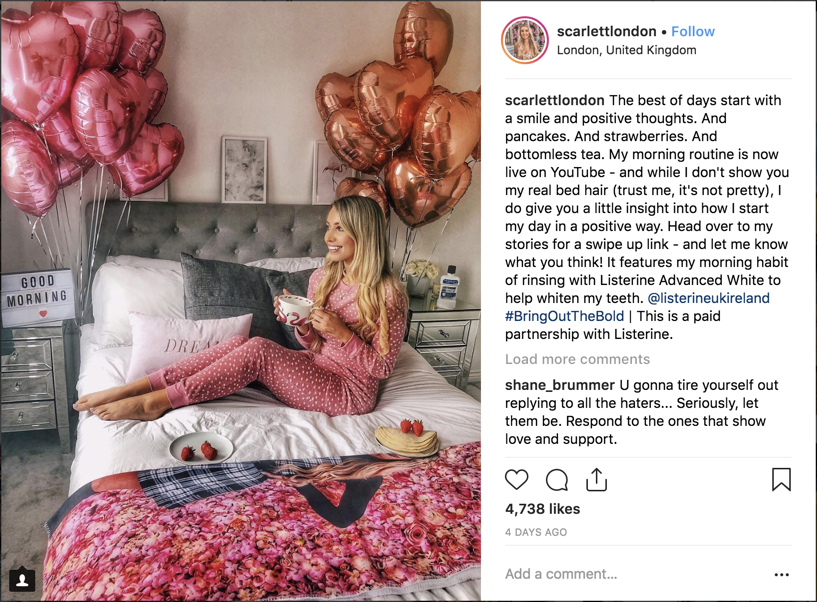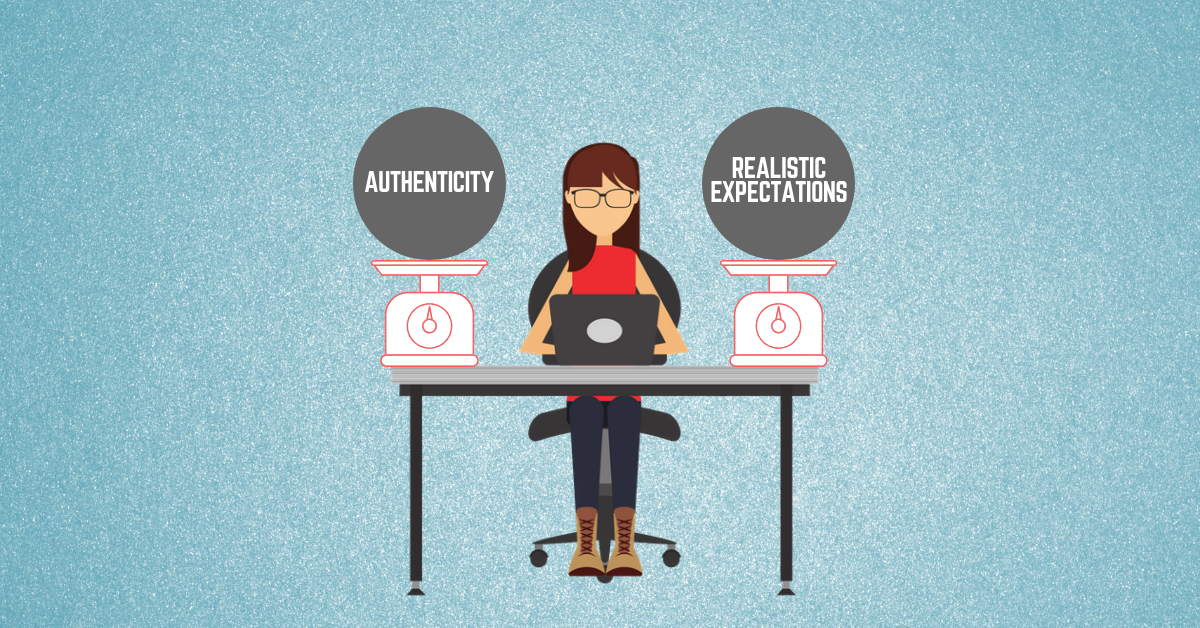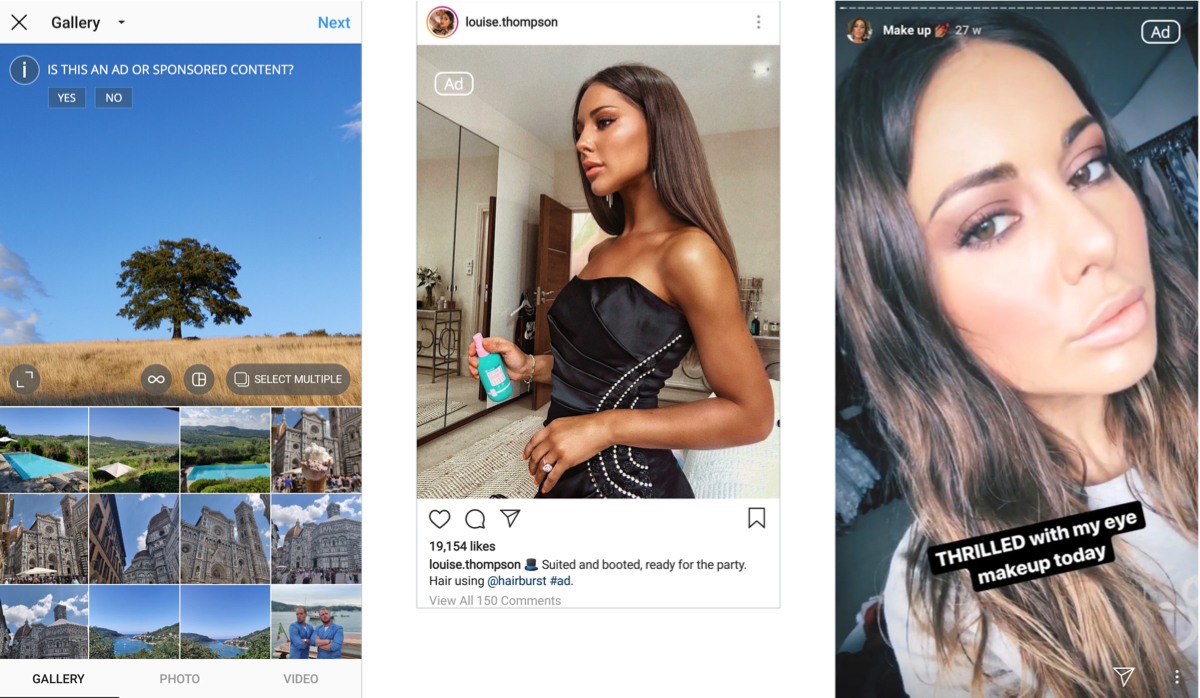There’s a lot of frustration being vented towards influencers and influencer marketing at the moment.
Some of that frustration is with the sector and its unregulated infancy. Some of the frustration is with people cheating the system. Some of the frustration is with the platforms. And some of the frustration is directed at influencers themselves.
Given influencer marketing was the go to tactic for retailers, travel brands and others less than 12 months ago, what has gone wrong, and how can the influencer marketing problems be fixed?
Let’s start with the post that kicked off a furore a couple of weeks ago: the Listerine Instagram ad posted by Scarlett Dixon.
I’m going to use this example to highlight what some of the issues with the sector are, and hopefully explain why wider society reacted in such an extreme way.

Influencer Marketing vs. Influencer Advertising
As a sector, we need to do a whole lot better with terminology. Using it, understanding it, and getting others to use it and understand it.
The Listerine example above is influencer advertising. Johnson & Johnson paying Scarlett to access her audience and incorporate a product placement into one of the posts. More often than not, a payment changes hands. If you look back through Scarlett’s Instagram feed, this is the only post you’ll find about Listerine.
Influencer marketing on the other hand is about establishing an authentic relationship with the influencer, which then builds an authentic relationship with the influencers audience. In successful influencer marketing campaigns, the promotion of the products or services are more naturally ingrained into the influencers content, and posted about regularly. As an example, Osprey backpacks have teamed up with several hiking bloggers and explorers.
So when people talk about how this is a bad example of influencer marketing, I tend to wince, because the whole influencer marketing industry is being tainted by something that is a poor example of influencer advertising.
For influencers, it is a balance of generating revenue in an authentic way, but also managing the expectations of an audience who are looking to connect with real-life stories and content.

Now some of you marketing purists will say that advertising is a form of marketing, so influencer advertising should fall under the influencer marketing umbrella, and in a sense, you are correct, but that leads me onto my next point about brand advertising versus human advertising.
Brands & Organisations vs. Real People
I saw a comment on LinkedIn which crushed the idea of authenticity in the case of the Listerine post. In my opinion he was correct, the Listerine post was anything but authentic.
But he also said the following: “What is authenticity when it come to advertising? The whole idea about advertising is to make believe. The point is the advertising is never about what is, but what would be possible.“. He has a point. Take the latest joint Waitrose and John Lewis advert for example – that would never happen at a regular school play. So why is there such a uproar when influencers stage content for an advert?
In Scarlett’s case she freely admitted that many of her posts are staged. In fact she goes as far to say that her feed ‘isn’t a place of reality‘.
And thus, we hit the crux of the problem in influencer marketing & advertising: because influencers are humans (as in real people), there is a level of trust and authenticity that should emanate from their content and social media feeds. When this doesn’t happen, we as the audience, as fellow humans, feel cheated. It’s ok for brands and organisations to stage adverts, because that’s what we know. That’s the norm. It’s what we’ve seen on billboards, on TV and online for years. But when an influencer does the same thing and stages something that is unrealistic and not aligned with our expectations, our trust is lost and our brains melt.
The Audience View
Authenticity is important in all forms of marketing, especially in today’s world which is filled with fake news. But above all, authenticity is required (expected) by influencers, because they aren’t viewed by their audience as brands. They are seen as people. People the audience can connect with.
I am a travel blogger in my spare time. It gives me a great position of being able to see both sides of the fence: that of a marketing perspective, and the perspective of an influencer.
What I learnt very quickly is that the audience buys in to who you are online. So do friends. They expect you to be the same person online as you are offline. With me, I try and do that to the best of my ability, but for others, they are completely different people online than they are offline (I’ll come back to this point in a second).
As such, if I ever promoted something that ‘didn’t fit’ in the eyes of the audience and my friends, they would call me a sell out and make it known that I’d stepped out of line.
I don’t rely on income from travel blogging to sustain a living. Influencers who create content and rely on brand collaborations for their income on the other hand may go chasing the pound notes to pay the bills even if the collaboration doesn’t quite fit with their images or regular content topics. By doing this, they can often ‘sell out’, which can alienate and annoy their followers.
Social media has allowed people to get closer to their idols and heroes. By sending a tweet directly to them, you know they’ll have seen it. It’s that easy. A far cry from the days of fan mail and lingering outside hotels to see if you could catch a glimpse of the stars. But it’s also made people cocky. Arrogant. Many people hide behind their social media masks, turn into trolls and hurl abuse at anyone who’s posts or opinions conflict with their life in some way. There’s no excuse for online abuse, and whilst the social networks are doing what they can to cut it out, a lot more needs to be done.
Frustrations Towards Influencers & Influencer Marketing
Scarlett’s post hit the mainstream news because of a tweet that highlighted that her post was anything like a normal morning.
What then happened was everyone who saw the post – and weren’t used to Scarlett’s pink and pretty feed – immediately slammed her for being false and contributing to the Instagram ‘lie factory’. Now, let’s get one thing straight immediately. Scarlett received death threats. That is NOT ok.
There was a lot of frustration directed at Scarlett and the post. But let’s be honest, this was more like the straw that broke the camels back.
Here’s where I think the frustration towards influencer marketing comes from:
- ‘Here’s How I Make Six Figures And Travel Round The World’ type posts – when these type of get rich quick articles started hitting the mainstream news and media a few years ago, it started to create unrealistic expectations. It was like putting up an imaginary neon sign in front a young social media audience that said ‘you can do this too!‘. Influencers started springing up all over the place, fighting tool and nail to get as big a following on Instagram and the other platforms as possible, with the aim of getting paid loads of money for simply creating posts on Instagram. Many people – and authentic influencers – frowned at this.
- The Rise Of The Bots – one of the ways many users gamed Instagram was to buy followers, or use bots to artificially inflate their engagement and follower levels. This is a BIG bug bear of mine because bot use is rife. Instagram lifted their head out of the sand to shut down one bot platform and a few others, and then promptly shoved their head back in the sand. This hit the news when it was discovered politicians and celebrities had used such methods to artificially inflate their followers. In fact, Unilever, L’Oreal, eBay, Samsung and Diageo were all in agreement that Instagram fraud is a big problem, and are trying to find solutions to solve it. Thus, trust towards Instagram, celebrities and other high profile users plummeted.
- The Cambridge Analytica Scandal – this blew the lid of user privacy and couldn’t have been timed any worse, given the GDPR regulations came into force shortly after. Facebook, Instagram, Twitter and Google got slammed, and the fallout still continues. If user trust in these platforms was low, it couldn’t get much lower following the scandal.
- Influencer Insensitivity – remember when Logan Paul stumbled across a dead body in Japan, but still decided to include it in his vlog? Quite rightly, there was a uproar, and everything from insensitivity to stupidity was levelled at the YouTuber, which then tainted other creators.
- Influencers Asking For Free Hotel Stays – back in January 2018, Elle Darby contacted the The White Moose Hotel in Dublin for a free, five-night stay in return for publicity on YouTube and Instagram. The owner turned the request public, and subsequently banned social media influencers from staying at the hotel. This reached the mainstream news, and generated a lot of negative sentiment towards influencers. This is beginning to happen more and more. For hotel stays. For flights. For products. As influencers we baulk at the idea of doing something for exposure, so why do we expect hotels, airlines and retailers to give influencers something for just exposure? Similar to the first point above, those outside the influencer marketing industry frowned at this because of the sense of entitlement.
- Disclosure Was Slow To Take Off – it was a couple of years before Facebook, Instagram, Snapchat, Twitter, YouTube and the ASA finally took a stance against influencer ads. Only in June 2017 did Instagram finally launch a tagging feature to allow influencers to clearly label sponsored posts, ads and collaborations. There has been calls with any ads or collaborations on social media to be clearly labelled, and whilst the ASA are starting to police it, there is still a lot more that can be done by the social networks to clearly identify an advert.
All the points above have led the industry to this point. There is scrutiny on influencer marketing from all angles, and rightly so in many cases. But how do we fix that?
Potential Solutions?
It’s not just influencers that need to regain trust, it’s the whole influencer marketing sector. Here are my thoughts on the potential solutions to the problems:
1) The Social Platforms Need To Step Up And Stop The Bots – how Instagram (Facebook) has got away with allowing bots and fake accounts for so long is unfathomable. But the problem is now so massive and widespread that the only people that can solve it are the platforms themselves. They need to cull the bots, have much better control over APIs and who uses the APIs and for what purposes, and then – most importantly – cull the accounts that have created the plagued system.
2) Require More Than Simply An Email Address To Set Up An Account – it takes two minutes to set up an email address. Then all the social networks need is verification through that email address for the new account. This is partly the root of the problem. If we made it more difficult for people to create accounts, we wouldn’t have so many fake accounts in the first place. Two factor authentication for all is a start, and especially if only one mobile number can be assigned to one or two account, AND that mobile number can be verified against an actual person.
3) The ASA Needs To Make An Example Of Someone – non-disclosure still happens. A lot. A few people have had their knuckles wrapped by the ASA, but no-one has been fined as yet. According to the ASA website, there have been 8 rulings against influencer marketing and their social media content over the past 12 months (CAP codes 2.1, 2.3 and 2.4), but none have resulted in fines. Now, I appreciate it is difficult because both the influencer and the brand would be held accountable, but until someone is fined, and it hits the news, more people will simply get a slap on the wrist and the problem will continue. Take the example of Louise Thompson and Vanity Planet. Louise claimed she didn’t know she had to include the word “#ad” to her Insta Story (and thus, see my final bullet point below about disclosure).
4) A New Regulation Framework – influencers, advertising agencies, PR companies and brands all need to contribute to an influencer marketing framework that aims to regulate some of the activity that happens in the industry. This could be a specific process for setting up an ad campaign. It could dictate topic similarity, and potentially align brands and products with influencers that already post content about those same topics. It could inform a pricing model or ad inventory system, a bit like Tribe have done. None of these things could be possible. All of them could be possible, but we need to make a start regulating influencer marketing somehow.
5) Better Social Platform Disclosure Labelling – the social networks have taken steps in the right direction, but they need to do more. For example, there could be some sort of check box before people post an image, story, video or tweet clearly labelling whether the content is an ad or sponsored. A simple pop up explaining disclosure and ASA rules would help bring awareness to everyone that disclosure is require.
Below are just some mock up examples of how the labelling could look on Instagram:

Lastly I go back to the point about authenticity, integrity and selling out. It is down to the influencer and only the influencer to decide whether to work on an advert or campaign that they believe will strike a chord with their audience. That freedom of choice cannot be regulated, and nor should it be, but a lot of responsibility rests with influencer and bloggers in order to portray the influencer marketing industry in a positive light.
Here’s hoping the sector finds solutions to the problems soon.
Comments(4)
- Pingback: Lush Closes UK Social Media Accounts. Will Other Brands Follow Suit? - novel.
- Pingback: Celebrating Our First Year! – novel.
- Pingback: How Does Google's Sponsored Link Attribute Impact SEO? - novel.
- Pingback: How To Ask A Blogger To Promote Your Product – Tanyas Cafe

Leave a Comment